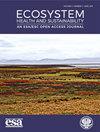臭氧浓度升高对印度亚热带草地群落特征和生产力有负面影响
IF 3.4
2区 环境科学与生态学
Q1 ECOLOGY
引用次数: 1
摘要
对流层臭氧对农业和自然植被构成严重威胁。本研究是为了研究完整的半自然草原群落在暴露于升高的O3(EO3;与环境O3(AO3)相比,环境+十亿分之20)下3年的结构和功能变化。对物种丰富度(SR)、均匀度(E)、香农指数(H′)、β-多样性(BD)、优势度浓度(Cd)、相似性指数(SI)、冠层生物量和群落生产力等参数进行了评价。犬齿齿苋、环纹Dichanthaum annulatum、Parthenium hysterphorus、血红Digitaria bloganalis、Cyperus killinga、Oplismenus burmanii和鸭跖草(Commelina benghalensis)等物种显示出更高的重要性值指数(IVI),而三叶草、三足草、山柳、,与AO3相比,在EO3处理下无翅Lindernia anagallis显示出更低的IVI。EO3增强了群落中的BD和Cd,而SR、E和H′降低。在EO3处理下,与底部和中间冠层相比,上部冠层和草本部分的生物量积累减少最大。与地上生物量相比,总生物量的减少幅度更大,表明向根系的碳分配更少。本研究的结果清楚地表明,在EO3水平下暴露3年对草原群落造成了有害影响,增加了耐O3物种,减少了敏感物种,从而导致物种组成和群落生产力的变化。本文章由计算机程序翻译,如有差异,请以英文原文为准。
Elevated Ozone Negatively Affects the Community Characteristics and Productivity of Subtropical Grassland in India
Tropospheric ozone (O
3
) is found to be a severe threat to agriculture and natural vegetation. The present study was conducted to investigate the structural and functional changes in an intact seminatural grassland community when exposed to elevated O
3
(EO
3
; ambient + 20 parts per billion) compared to ambient O
3
(AO
3
) for 3 years using open-top chambers. Parameters such as species richness (SR), evenness (
E
), Shannon index (
H
′), β-diversity (BD), concentration of dominance (Cd), similarity index (SI), biomass in canopy layers, and community productivity were evaluated. Species like
Cynodon dactylon
,
Dichanthium annulatum
,
Parthenium hysterophorus
,
Digitaria sanguinalis
,
Cyperus killinga
,
Oplismenus burmannii
, and
Commelina benghalensis
showed higher importance value index (IVI), whereas
Trifolium resupinatum
,
Desmodium triflorum
,
Melilotus officinalis
,
Oxalis corniculata
,
Eleusine indica
,
Cyperus rotundus
,
Malvestrum coromandelianum
, and
Lindernia anagallis
showed lower IVI under EO
3
treatment compared to AO
3
. EO
3
enhanced BD and Cd, whereas SR,
E
, and
H
′ in the community reduced. Biomass accumulation reduced maximally in top layer compared to bottom and middle canopy layers in both forbs and grasses fraction under EO
3
treatment. Higher reduction in total biomass compared to aboveground biomass indicates less carbon allocation toward root system. The results of the present study clearly indicates that 3 years of exposure at EO
3
level caused deleterious impact on grassland community by increasing O
3
-tolerant and decreasing sensitive species, thus resulting in a shift in species composition and community productivity.
求助全文
通过发布文献求助,成功后即可免费获取论文全文。
去求助
来源期刊

Ecosystem Health and Sustainability
Environmental Science-Management, Monitoring, Policy and Law
CiteScore
7.10
自引率
2.00%
发文量
40
审稿时长
22 weeks
期刊介绍:
Ecosystem Health and Sustainability publishes articles on advances in ecology and sustainability science, how global environmental change affects ecosystem health, how changes in human activities affect ecosystem conditions, and system-based approaches for applying ecological science in decision-making to promote sustainable development. Papers focus on applying ecological theory, principles, and concepts to support sustainable development, especially in regions undergoing rapid environmental change. Papers on multi-scale, integrative, and interdisciplinary studies, and on international collaborations between scientists from industrialized and industrializing countries are especially welcome.
Suitable topics for EHS include:
• Global, regional and local studies of international significance
• Impact of global or regional environmental change on natural ecosystems
• Interdisciplinary research involving integration of natural, social, and behavioral sciences
• Science and policy that promote the use of ecological sciences in decision making
• Novel or multidisciplinary approaches for solving complex ecological problems
• Multi-scale and long-term observations of ecosystem evolution
• Development of novel systems approaches or modeling and simulation techniques
• Rapid responses to emerging ecological issues.
 求助内容:
求助内容: 应助结果提醒方式:
应助结果提醒方式:


